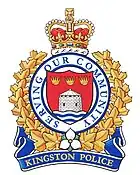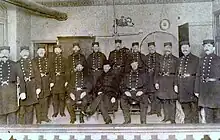| Kingston Police Service De Police De Kingston | |
|---|---|
 Badge worn by Kingston Police Officers. | |
| Common name | Kingston Police |
| Abbreviation | KPF |
| Motto | "Ontario's Finest" "Serving Our Community" |
| Agency overview | |
| Formed | December 20, 1841; 181 years ago |
| Annual budget | $44,366,789 Million CAD (2023)[1] |
| Jurisdictional structure | |
| Operations jurisdiction | Municipality of the City of Kingston |
| Size | 451.58 square kilometres (174.36 sq mi) |
| Population | 132,485 (2021)[2] |
| Legal jurisdiction | Municipal |
| Governing body | Kingston Police Services Board |
| General nature | |
| Operational structure | |
| Headquarters | 705 Division Street, Kingston Ontario Canada [3] |
| Sworn Officers | 201 (2022) [4] |
| Civilian Employees | 99 (2022) |
| Elected officer responsible |
|
| Agency executive |
|
| Boroughs | 7
|
| Facilities | |
| Police Stations | 1 (The Kingston Police Headquarters) |
| Police Vehicles | 45 |
| Dogs | 2 |
| Website | |
| Official website | |
The Kingston Police is the municipal police force for the city of Kingston, Ontario. It was established by the Common Council of Kingston on December 20, 1841, making it one of the oldest police forces in Canada. Today, the Kingston Police is made up of approximately 300 members serving an area of 451.58 square kilometers and 132,485 (2021 Census) people.
History
The Kingston Police Force was established by the Common Council of Kingston on December 20, 1841, in an attempt to manage the lawlessness in the capital of the former Province of Canada. The original police force comprised a Chief Constable and four sub-constables. Despite their best effort, the force's growth was limited due to monetary restraints. In the 1850s, they were composed of about 8-10 officers growing to about a dozen in the 1860s, where it remained until the early 20th century.

Following World War II, the force finally began growing at a more consistent rate. In 1990 they had expanded to 116 sworn officers serving a population of over 60,000 inhabitants. The 1990s were a tough decade for the Kingston Police Force. In 1993, the Social Contract Act was put in place by the government in an attempt to address budget deficits. This resulted in a major loss in funding, ultimately leading to the reduction of the force to 101 officers. In 1996, the province introduced additional cost-saving initiatives such as the Savings and Restructuring Act, which merged smaller municipalities with their neighbours. In 1998, both the Kingston Township and the Pittsburgh Township were merged into Kingston City, nearly doubling its population. During this transitional period, the Ontario Provincial Police assisted the KPF in managing its population, however, by the end of the decade, the Kingston Police Force having now grown to nearly 150 sworn officers, re-claimed full control over their newly expanded jurisdiction. By 2011 the force had grown to 198 officers and 60 civilian employees.[5]
Divisions
The Kingston Police currently has four separate divisions each responsible for a separate area of policing.
Patrol Division[6]
- Patrol Unit
- Emergency Response Unit (ERU)
- Canine Unit (K9)
Investigative Services Division[6]
- Criminal Investigations Unit
- Forensic Identification Unit
- Internet Child Exploitation Unit
- Sexual Assault and Child Abuse
Operational Support Division[6]
- Community Oriented Response and Engagement (CORE)
- Beat and Bicycle Units
- Community Operations
- School Resource Officers
- Traffic Safety Unit
- Collision Reconstruction Unit
- Youth Officer
- Volunteer Unit
Administrative Support Division[6]
- Communication Unit
- Court Services Unit
- Records Unit
- Training Unit
Former Chiefs
| Name | Start of term | End of term | Notes[7] |
|---|---|---|---|
| Antje McNeely | November, 2018 | January, 2023 | Hired in April 1985, McNeely holds the distinction of being the first female officer to hold the ranks of staff sergeant (December 2001), inspector (January 2007), Deputy Chief (July 2011), and Chief of Police (November 2018). |
| Gilles M. Larochelle | June, 2013 | July, 2018 | Prior to his position as Chief of Police, Larochelle had over a decade of extensive experience within the senior command structure in the Ottawa Police Service. He served as an inspector, superintendent, and deputy chief in various assignments. |
| Stephen J. Tanner | November, 2008 | September, 2012 | Tanner held various policing positions within the province, including Deputy Chief of Operations with the Guelph Police Service, Chief of Police in Belleville, ON, President of the 2012/13 Ontario Association of Chiefs of Police, and Chief of Police in Kingston. |
| William J. Closs | August, 1995 | 2008 | Reached a commemorable rank of Chief Superintendent with the Ontario Provincial Police before serving as the Chief of Police in Kingston. |
| William R. Hackett | 1994 | 1995 | Hackett joined the Kingston Police in 1951, and served for 44 years until his retirement in 1995. He holds the lengthiest recorded service within the Kingston police ever. A city park was named in his honour. |
| Gerald S. Rice | 1976 | 1994 | Died of a heart attack one month before his retirement. |
| Roland R. Smith | 1974 | 1976 | Died in office. |
| Robert W. Nesbitt | 1959 | 1974 | He was the grandson of Robert Nesbitt who served as Chief of police in 1918. |
| John T. Truaisch | January, 1947 | October, 1959 | Truaisch served as the 1955/56 President of the Ontario Association of Chiefs of Police; he died in office. |
| Captain Robert J. Robinson | October, 1919 | December, 1946 | Robinson was appointed for 27 years, making him the longest serving Chief of Police in Kingston. |
| Robert Nesbitt | December, 1918 | 1919 | Nesbitt is alleged to have served as an officer in Liverpool for several years prior to immigration to Canada. He died in office after serving in Kingston for over 42 years. |
| William Baillie | May, 1899 | December, 1918 | |
| Captain Edwin Horsey | 1881 | April, 1899 | |
| Colonel S. B. Hance | November, 1874 | 1881 | An American who was appointed, despite much protest from locals. |
| John Robb | September, 1870 | October, 1874 | Died in office. |
| Robert Channonhouse | 1849 | 1870 | Previously a counsellor for the Ward of Ontario. |
| Samuel Shaw | December, 1841 | March, 1849 | Before becoming chief, Shaw was the High Bailiff. |
Source:[8]
Ranks and insignia
The rank insignia of the Kingston Police Force is similar to that used by some police services elsewhere in Canada and in the United Kingdom, except that the usual "pips" are replaced by maple leaves. The St. Edward's Crown is found on insignia of staff sergeant, all superintendent ranks and all commanding officer ranks.
| Rank | Commanding Officers | Senior Officers | Police Officers | ||||||
|---|---|---|---|---|---|---|---|---|---|
| Chief of police | Deputy chief of police | Staff Inspector | Inspector | Staff sergeant | Sergeant | Senior police constable | Constable | ||
| Insignia
(slip-on) |
 |
 |
 |
 |
 |
 |
 |
 | |
| Insignia
(shoulder board) |
.png.webp) |
.png.webp) |
.png.webp) |
.png.webp) |
Shoulder boards not used for these ranks | ||||
References
- ↑ "Quarterly Report – Kingston Police Services – Q1 2023" (PDF). www.cityofkingston.ca. June 20, 2023.
- ↑ Government of Canada, Statistics Canada (February 9, 2022). "Profile table, Census Profile, 2021 Census of Population - Kingston, City (CY) [Census subdivision], Ontario". www12.statcan.gc.ca. Retrieved October 26, 2023.
- ↑ "Contact Us". April 12, 2021.
- ↑ Public Agenda Information Report esolg.ca
- ↑ "Our History". www.kingstonpolice.ca. January 24, 2023. Retrieved October 26, 2023.
- 1 2 3 4 "Sections and Units". www.kingstonpolice.ca. February 26, 2023. Retrieved October 26, 2023.
- ↑ "Our History". www.kingstonpolice.ca. October 26, 2023. Retrieved October 26, 2023.
- ↑ The Keepers of the Peace kpf.ca